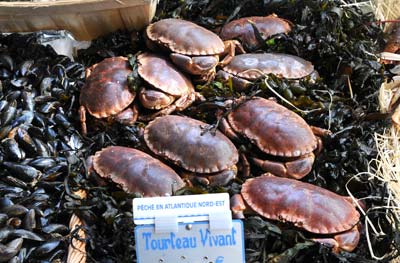The default crab differs from country to country. The most common type of crab caught commercially in northern Europe is a large clawed variety known as the "edible crab" measuring as much as 20 cm (8”) across. In the South you are more likely to find the delicious spider crab, which can be great wanderer, moving tens, if not hundreds, of miles during a year from feeding to spawning grounds. Spider crabs only provide meat from the legs but it is of very high quality. Also commoner in the south are soup crabs such as shore, furry or swimming crabs. In the US the crab commonly refers to the Dungeness crab on the Pacific coast or the blue crab, often in its soft-shelled state, in the East.
The brown meat is held inside the carapace or shell, while the white meat is found, with a little effort, in the claws. The white meat consists mainly if muscle, while the much tastier brown meat is made up of digestive glands, effectively the liver or its equivalent, and reproductive organs. Amazing, but in the end not that surprising, how the liver of so many creatures provides such dense flavour.
Baited pots are used for capture, often far from the shore. Any fresh whole crab should be heavy for its size and there should be no sound of water sloshing around in it. The shell must be perfectly entire with no cracks or holes. Break the top from the rest and spoon out the brown meat. Discard the feathery gills and the small stomach sac. Crack open the legs and extract the white meat from the claws. I prefer a good fresh crab to lobster, though a good fresh lobster will do! It is illegal to land hen crabs in berry.
